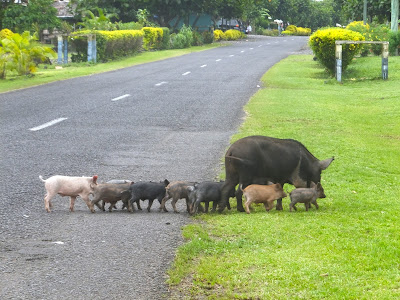It has been quite a while since my last post. Since writing you last, I made my way to Australia for the first time, and I passed the six month mark for my fellowship. Being off island gave me a bit of time to reflect on my experience so far, and I thought I’d dedicate this post to sharing a few of my thoughts with you.
Life as an Apia expat is a strange mixture of simplicity and opulence.
To live the life of an expat in Apia is to live in a constant series of contradictions.
My life in Apia has been marked by a simplicity that I have greatly appreciated. Freed from the constant buzz and frenetic consumption that settled like a fog over my previous daily routines, I have found the space to think and grow. With less access to certain goods and services, I have learned to make do, adapt, and innovate. I learned that many things I took for granted as assumed parts of day-to-day life are not as essential as I once thought. If a house isn't equipped with hot water, I take a cold shower. If the internet is too slow to use in the early evenings, I wait to send messages and Skype friends and family until just before bed. And life moves on.
While life in Apia has removed a great deal of the noise and excess from my day-to-day life, I am still able to enjoy certain luxuries that most Samoans would rarely enjoy – if at all. I would have a hard time living off my monthly stipend in the US, but I am able to live quite comfortably in Samoa and am earning more than a lot of average Samoans.
How do I reconcile these two opposing parts of my Fulbright experience?
Fully exploring a new country and culture means discovering the full range of day-to-day life experiences – pros and cons, good and bad, awe-inspiring and deeply frustrating.
Through both this and previous experiences abroad, I have come to appreciate more fully what at first seems rather obvious: no country is perfect. When we’re on vacation, it’s very easy to expect to only live through the neatly packaged Kodak moments that we flip through to remember our trips. And how could an extended period of time abroad not be equally as idyllic? But really, while the actual routine may differ, day-to-day life is day-to-day life everywhere. The peaks and valleys of daily living are just a bit more extreme when you’re living abroad.
This realization gradually came to me as I studied and worked in France. As a teenager, France was my dream destination, a perfect place that would magically fix any frustrations I had with how things were done at home. So I studied abroad in the Loire Valley for a semester of undergrad, and with half a year of freedom to explore without any real responsibility, these expectations were largely confirmed. I returned to France a few years later to complete my Master’s, confident that my experience would be the same.
I soon discovered that life in France as an independent adult was not just an extended Erasmus experience. While there are countless things about French life and culture that I love, I also began to gradually discover things that frustrated or confused me. And, much to my surprise, I began to find things that I preferred about home.
My experience in Samoa has been very similar. People at work and around town have been wonderfully kind and welcoming. And every time I make a weekend trip to the beach or even walk home from work, I am taken away by the beauty of this place. But even life in paradise has its down sides. I would love to go to one grocery store for all my shopping and find a range of fresh fruits and veggies the way I could at home. I wish that I didn't have to think about protecting myself from territorial dogs as I made my way through the neighborhoods around town.
And I have been confronted by more serious challenges and issues. I have heard several stories about children being beaten or intimidated through threats of violence both at home and at school. Domestic violence rates are incredibly high. I see the high levels of obesity, diabetes, and heart disease because of limited access to affordable, healthy food. It is very easy to become overwhelmed. But what is my point of comparison? My vision of home is marked by the unjust deaths of Trayvon Martin, Michael Brown, and Freddie Gray. The widening gap between rich and poor. Equally alarming, high rates of obesity and heart disease. The longer you stay in a place, the more you uncover the layers upon layers that combine to make up life in that country.
In a new place, I see the first step as observing, learning, and exploring in order to peel away those layers. With only ten months in Samoa, I will have only begun to work my way through this first step. Over time, as a place becomes a home, we can then work on finding ways to take the beautiful parts of that home and use them constructively to pick away at the challenges people face from day to day.










